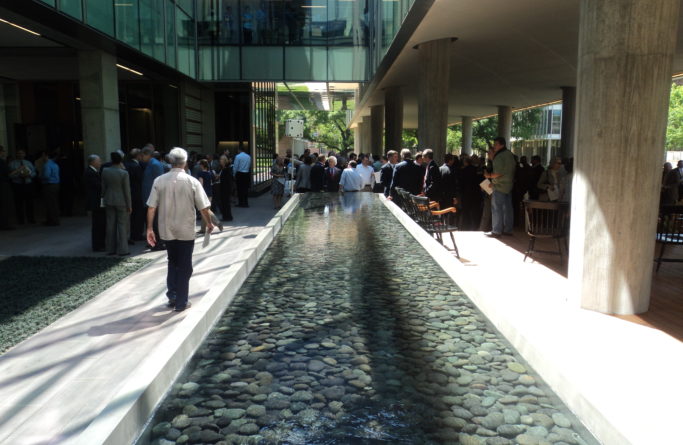More than 150 gathered Thursday to celebrate the official dedication of Brockman Hall for Physics, Rice’s new state-of-the-art home for fundamental and applied physics research. A delegation of officials from the National Institute of Standards and Technology (NIST) joined Rice Board of Trustees Chair Jim Crownover, Rice President David Leebron, astronaut and Rice alumna Shannon Walker and others in unveiling the 111,000-square-foot, four-story building.
“Since its founding, Rice has cared so much about architectural beauty, cutting-edge research, and environmental sensitivity,” Crownover said. He noted that all three of those principles are evident in this “magnificent building.”
“Brockman Hall enhances Rice’s status as one of the nation’s premier research universities, and it ensures that Rice will remain a leader in fundamental and applied physics research for years to come,” Leebron said. “The impact of Brockman Hall goes beyond bricks and mortar. This facility forges new pathways between science and engineering, between theory and practice and between Rice’s first and second centuries.”
Special guests at the dedication ceremony included Patrick Gallagher, undersecretary of commerce for science and technology and NIST director; Robert Celotta, director of NIST’s Center for Nanoscale Science and Technology; and Walker.
Rice faculty and staff began moving into Brockman Hall last month. When fully occupied in June, the building will be home to dozens of experimental, theoretical and applied physicists from Rice’s departments of Physics and Astronomy and of Electrical and Computer Engineering. Brockman Hall will support research in atomic, molecular and optical physics; biophysics; condensed matter physics; nanoengineering and photonics.
The facility is special for several reasons: It was designed, constructed and occupied in just 33 months; it brings together faculty and students who formerly worked in five separate buildings scattered broadly across the campus; it is both a carefully refined 21st-century research facility and one of the most environmentally sustainable buildings at Rice; and it maintains much of the outdoor space that previously existed on Rice’s Science Quadrangle.
Brockman Hall is composed of two parallel, rectilinear, spatial “bars” that are oriented east to west and connected by glass-enclosed bridges across an open passage that admits natural light and outdoor breezes. The larger south bar houses laboratories, faculty and research offices, a 150-seat lecture hall and a rooftop astronomical observatory. The elevated two-story north bar houses faculty, student and departmental offices and meeting spaces.
The open space beneath the north bar is framed by a “loggia” of tapered concrete columns that form an outdoor room, with shaded areas for class meetings, casual gathering, and circulation. Beneath this serene outdoor oasis lies a sensitive and sophisticated complex of laboratories. Designed for vibration-sensitive atomic, molecular and optical physics and condensed-matter research, the hermetically controlled basement laboratories are stabilized on a two-foot-deep concrete slab and isolated from all the building’s mechanical systems. State-of-the-art equipment supplies these labs with “clean” electrical power, chilled water and filtered air that is cleansed of submicroscopic dust.
